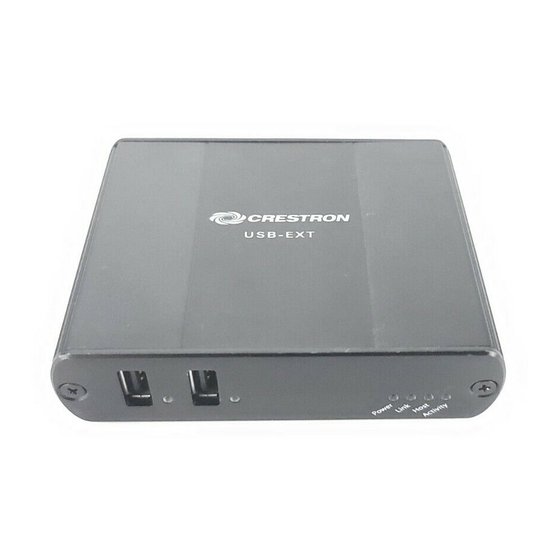
Advertisement
USB-EXT
USB over Twisted Pair Extender
Introduction
1
®
The Crestron
USB over Twisted Pair Extender (USB-EXT) delivers
reliable USB signal extension for use in a boardroom, classroom,
auditorium, command center, or residence. Without any special setup
or configuration, the USB-EXT enables wire runs up to 100 meters
(~330 feet) over a single, low-cost twisted-pair cable.
The USB-EXT is compatible with USB 1.1 and High-Speed USB 2.0,
supporting virtually any USB device such as keyboards and mice,
game controllers, cameras, mobile devices, printers, hubs, and
memory devices. It is compatible with Windows
computers without requiring any additional drivers.
NOTE: Crestron does not guarantee that all USB devices are
compatible with the USB-EXT.
The USB-EXT is composed of two extender components. The "local"
extender connects to your computer or other USB host, while the
"remote" extender provides connections for your USB devices at
some remote location. Linking the two extender components requires
just one run of inexpensive CAT5 (or better) twisted-pair cable.
The USB-EXT contains a local extender, remote extender, power
supply and a USB cable.
2
Mounting
After determining where the local computer and remote USB
device(s) are to be placed, place the local and remote boxes of
the USB-EXT on a flat surface near each of the two locations.
The rubber feet help ensure the units do not slip.
Installing
3
1. Insert the supplied USB cable in the local extender and in an
available USB Type A port on the computer.
2. Using CAT5 (or better) cable, connect the Link ports of the local
and remote extenders.
3. Plug the power adapter into the local extender and then plug the
24V power adapter into an AC outlet.
NOTE: If using pre-installed in wall CAT5 wiring, plug one end of the
CAT5 patch cable (not supplied) into the Link port on the local
extender. Plug the other end of the patch cord into the wall outlet
near the host computer. Plug one end of the second CAT5 patch
cord (not supplied) into the Link port on the remote extender. Plug
the other end of the second patch cable into the wall outlet near the
USB device. Make sure that the two patch cables and in wall cabling
does not exceed 100M (~330 feet).
1
For Regulatory Compliance information,
refer to the latest version of Doc. 7205.
QUICKSTART DOC. 7204A (2031178)
To USB hub or
USB HID devices
®
®
and Mac
Remote Extender Front
4
Connecting a USB Device
1. On the PC, install any software required to operate the USB device(s). Refer to the documentation for the USB device(s) as
required.
2. Connect the USB device to either USB port on the front of the remote extender.
3. Check that the device is installed and detected properly by the operating system.
Checking the Installation
5
On the local and remote units, check that the Power, Host and Link LEDs are on and that the Activity LED for the connected
USB port is blinking. If any LED is permanently off, then the cabling between the local and remote units is not properly installed
or is defective.
Verify device is properly installed on computer:
For Windows Users:
Open Device Manager to confirm that that USB-EXT has been installed correctly. Expand the entry for Universal Serial Bus
controllers by clicking the + sign. If the USB-EXT has been installed correctly, you should find it listed as a "Generic USB
Hub".
For Mac OS X Users:
Open the System Profiler to confirm that the USB-EXT has been installed correctly. In the left hand column under Hardware,
select "USB" and inspect the right hand panel. If the USB-EXT has been installed correctly you should find it listed as a
"Hub" under the USB High-Speed Bus/USB Bus.
If the unit is not detected correctly or fails to detect, please consult the Troubleshooting section on the following page.
www.crestron.com
05.11
Specifications subject to
change without notice.
Link
Remote Extender Rear
CAT5 Cable
888.273.7876
201.767.3400
To AC Outlet
To PC or
USB Hub
DC IN 24V @ 1A
Link
Local Extender Rear
Local Extender Front
Advertisement
Table of Contents

Summary of Contents for Crestron USB-EXT
- Page 1 Open Device Manager to confirm that that USB-EXT has been installed correctly. Expand the entry for Universal Serial Bus 24V power adapter into an AC outlet. controllers by clicking the + sign. If the USB-EXT has been installed correctly, you should find it listed as a “Generic USB Hub”.
- Page 2 Crestron and the Crestron logo are trademarks or registered trademarks of Crestron Electronics, Inc. in the United States and other countries. Mac is a trademark or registered trademark of Apple, Inc. in the United States and/or other countries.















Need help?
Do you have a question about the USB-EXT and is the answer not in the manual?
Questions and answers